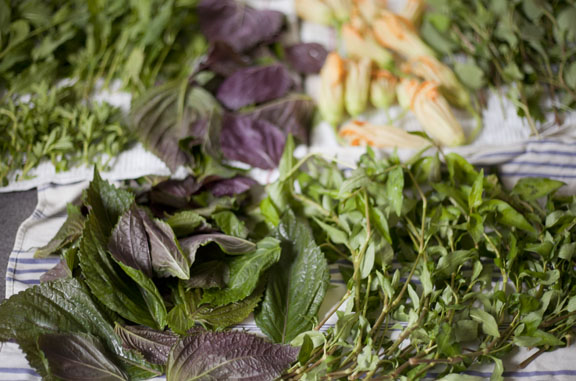After all that meal planning and grocery shopping, the real fun begins…
Saving time with prep work. I have a certain system I like to follow each week. Upon returning home from the grocery store, I make sure the dishwasher and sink are cleared. I go through the fridge and toss out anything that’s gone bad. I also take this opportunity to do a wipe-down of the fridge if it needs it. I then wash and chop most of my produce, storing things in containers or in Ziplock bags lined with a paper towel to soak up some of the moisture. If necessary, after washing and spinning, I’ll lay greens out on kitchen towels to dry before storing, as the moisture makes them go bad more quickly. I often keep containers of chopped scallions, fried shallots, chopped onion, and other often-used ingredients ready in order to speed up cooking later on. For example, it’s easy to cook up a quick omelette in the morning by grabbing the pre-chopped onion and scallions and tossing in some prewashed spinach leaves.
 Viet herbs and squash blossoms, washed and spun, now laid out to dry on kitchen towels; ready for Vietnamese wraps, noodle bowls, and soups later in the week.
Viet herbs and squash blossoms, washed and spun, now laid out to dry on kitchen towels; ready for Vietnamese wraps, noodle bowls, and soups later in the week.Batch cooking. If it weren’t for the cleanup that ensues (and, oh, all the other non-food-related work I have to do), I could easily and happily spend every moment of the day cooking. What actually happens, though, is that I have one or two cooking sessions each week — a more involved one on the weekend and a less involved one about mid-week. On an average weeknight, I’m either repurposing leftovers, reheating a pre-made meal, or using ingredients prepped ahead of time to cook up a quick dish or two. One of the greatest advantages of batch cooking, I find, is that it not only makes cooking more efficient — it also makes cleanup more efficient.
While I’m doing prep work on the weekend, I cook up large batches of certain things for the week, like oatmeal, rice, and steamed veggies. I know my sister likes to boil a bunch of eggs to throw into salads or have for breakfast. I also like to make a jar of vinaigrette for the week’s salads.
In addition to cooking several meals at once, I also increase the portions. Whenever I make a dish, I usually make enough of it to last at least two meals. I find that four meals is my limit for eating the same thing (and it has to be something I enjoy in the first place), and it’s helpful if those aren’t all in a row too. An easy rhythm to get into is to always double your dinner portions, so that you can bring the leftovers for lunch the next day. This doesn’t work so well with things like fish (and other smelly items), in which case it’s helpful to have some alternative ready-made meals to bring instead. For things that freeze well, I’ll quadruple the portions, saving enough for two meals now and freezing two meals for the future.
 One of my husband's packed lunches this week, made up of leftovers -- brown rice, steamed broccoli, poached chicken, and ginger scallion dipping sauce.
One of my husband's packed lunches this week, made up of leftovers -- brown rice, steamed broccoli, poached chicken, and ginger scallion dipping sauce.Repurposing ingredients and leftovers. I try to plan for dishes with overlapping ingredients in the same week. For example, if I’m getting cilantro and lime for some Vietnamese dishes this week, I’ll also work in some Mexican dishes, where those ingredients are prominent as well. I also mentioned earlier this week how I like to plan my menu around base meals and leave room for variation. We often use our poached chicken later in the week for noodle soups, salads, or chicken enchiladas. Meats are always easy to repurpose into things like wraps, sandwiches, and to add to salads and soups. Certain veggies can work this way too, like spinach or mushrooms, which often act as meat replacements in vegetarian dishes.
Do you cook every day? Do you have a process to make weeknight dinners more effficient? How do you handle breakfast and lunch?










Wow.. I should start with meal planning. Recently, I cook lots of simple soups and crockpot meals, since I don’t even have 30 minutes to cook at night these days. You’re so impressive with your methodology!
Well, I definitely have less time some weeks than others, so we have some shortcuts like rotisserie chicken, meals frozen from earlier cooking, and then there are always $5 Subway sandwiches, haha. The Crockpot is awesome!